Carlsberg Group: Strategic HRM, Winning Behaviours, Global Challenges
VerifiedAdded on 2023/03/23
|11
|2922
|59
Case Study
AI Summary
This case study examines Carlsberg's strategic human resource management, focusing on the 'Winning Behaviours' strategy and its implementation across different cultural contexts. It highlights the company's priorities, including employee satisfaction, work-life balance, and adapting to local markets. The rationale behind the 'Winning Behaviours' strategy, which aims to align business strategy with HR practices, is discussed, along with its alignment with equity, diversity, workforce planning, social responsibility, and work-life balance. The difficulties faced by Carlsberg in Malaysia, particularly concerning language barriers and cultural sensitivities, are analyzed. Furthermore, the case study assesses the potential success of the 'Winning Behaviours' strategy in an Australian context, providing recommendations for effective implementation, emphasizing the importance of employee engagement, empowerment, and aligning business processes with HR objectives to foster a responsible organizational culture.
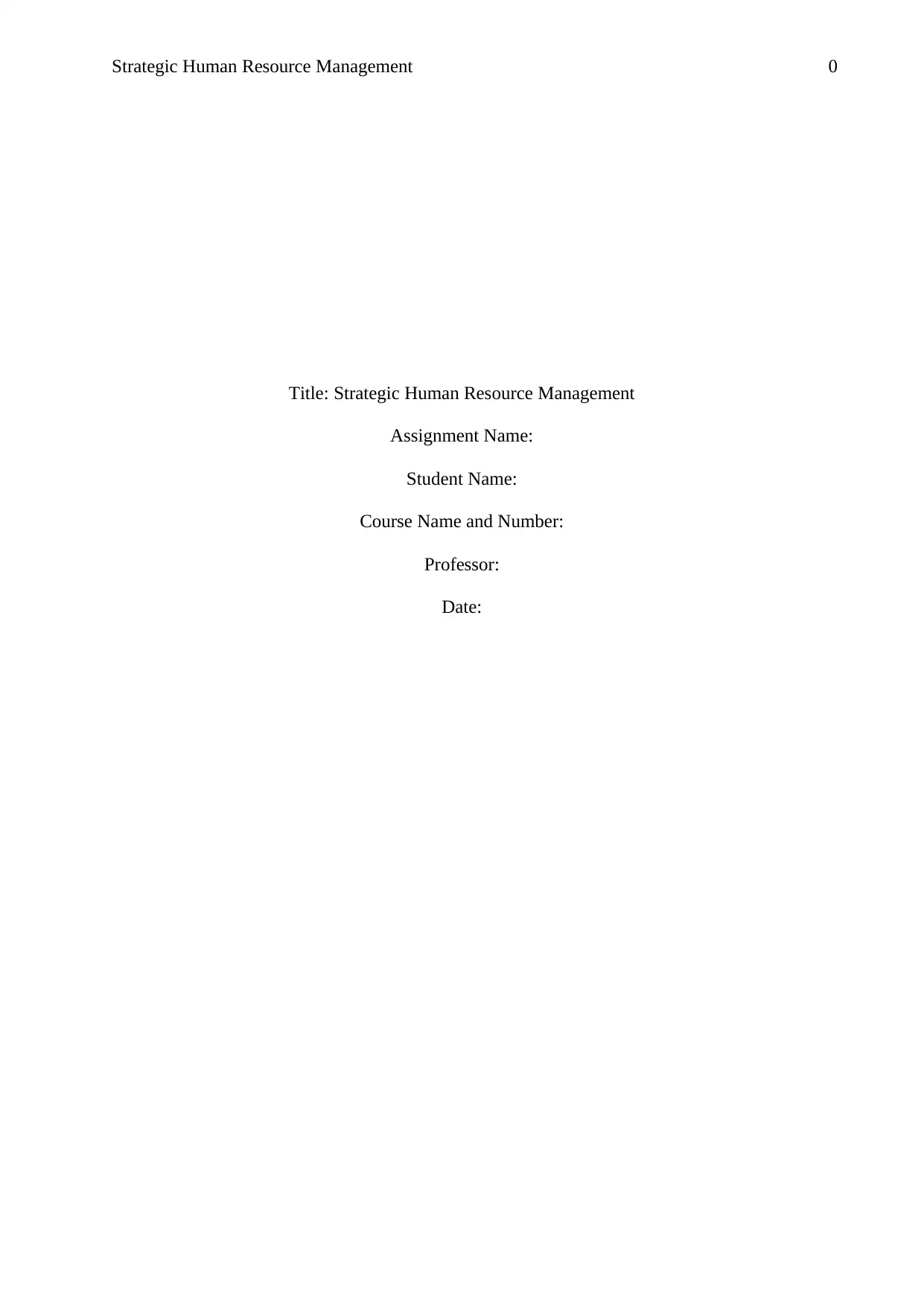
Strategic Human Resource Management 0
Title: Strategic Human Resource Management
Assignment Name:
Student Name:
Course Name and Number:
Professor:
Date:
Title: Strategic Human Resource Management
Assignment Name:
Student Name:
Course Name and Number:
Professor:
Date:
Paraphrase This Document
Need a fresh take? Get an instant paraphrase of this document with our AI Paraphraser

Strategic Human Resource Management 1
Contents
Introduction................................................................................................................................2
Carlsberg’s Strategic HR Priorities............................................................................................2
Rationale for Implementing the ‘Winning Behaviours' Strategy...............................................3
Alignment of ‘winning behavior’ and HR practices..................................................................4
Difficulties Faced by the Company in Malaysia........................................................................5
Analysis and Recommendations................................................................................................6
Conclusion..................................................................................................................................7
References..................................................................................................................................9
Contents
Introduction................................................................................................................................2
Carlsberg’s Strategic HR Priorities............................................................................................2
Rationale for Implementing the ‘Winning Behaviours' Strategy...............................................3
Alignment of ‘winning behavior’ and HR practices..................................................................4
Difficulties Faced by the Company in Malaysia........................................................................5
Analysis and Recommendations................................................................................................6
Conclusion..................................................................................................................................7
References..................................................................................................................................9

Strategic Human Resource Management 2
Introduction
Strategic Human Resource management is using the strategies to meet the needs of
the employees and the company's objective in the most effective way. It is planning the way
forward for the company in terms of its human resources. It is a process where best human
resource policies are formulated to help the employees grow and also in the fulfilment of the
company's objective. When applied at the international level, it becomes international
strategic human resources where multinational companies formulate their human resource
strategies at the international level to meet the global demands as well as create a culture for
employees to work in a diversified workplace.
Carlsberg’s Strategic HR Priorities
Carlsberg is no different from it. It framed the strategic human resource policies to
integrate at the international level as a multinational. The most important objective of the
company is that its employees should be satisfied and happy; to meet this goal they care
about their employees and make sure that there is a work-life balance in the lives of their
employees (Yuile, Chang, Gudmundsson & Sawang, 2012). The most important strategic HR
implementation is that when in the international market, the company adopts the theory of
going local, which means adapting itself to the local markets or the host country market needs
and demands (Beer, 2015). Therefore, to achieve this objective the company needs to create a
workforce which in diversified. It also means hiring the locals and promoting the culture at
the workplace which makes the integration of its human resources policies and the workforce
at the international level. Carlsberg gives its business processes and human resource
processes in the hands of the locals of the host country to develop a strategy for them as they
are well versed with the demands and needs of the local market. This makes it more effective
for the company to make its brand lead in the international market (Gertsen, Søderberg &
Zølner, 2012). The company has given priority to the cross culture in the management of its
Introduction
Strategic Human Resource management is using the strategies to meet the needs of
the employees and the company's objective in the most effective way. It is planning the way
forward for the company in terms of its human resources. It is a process where best human
resource policies are formulated to help the employees grow and also in the fulfilment of the
company's objective. When applied at the international level, it becomes international
strategic human resources where multinational companies formulate their human resource
strategies at the international level to meet the global demands as well as create a culture for
employees to work in a diversified workplace.
Carlsberg’s Strategic HR Priorities
Carlsberg is no different from it. It framed the strategic human resource policies to
integrate at the international level as a multinational. The most important objective of the
company is that its employees should be satisfied and happy; to meet this goal they care
about their employees and make sure that there is a work-life balance in the lives of their
employees (Yuile, Chang, Gudmundsson & Sawang, 2012). The most important strategic HR
implementation is that when in the international market, the company adopts the theory of
going local, which means adapting itself to the local markets or the host country market needs
and demands (Beer, 2015). Therefore, to achieve this objective the company needs to create a
workforce which in diversified. It also means hiring the locals and promoting the culture at
the workplace which makes the integration of its human resources policies and the workforce
at the international level. Carlsberg gives its business processes and human resource
processes in the hands of the locals of the host country to develop a strategy for them as they
are well versed with the demands and needs of the local market. This makes it more effective
for the company to make its brand lead in the international market (Gertsen, Søderberg &
Zølner, 2012). The company has given priority to the cross culture in the management of its
⊘ This is a preview!⊘
Do you want full access?
Subscribe today to unlock all pages.

Trusted by 1+ million students worldwide
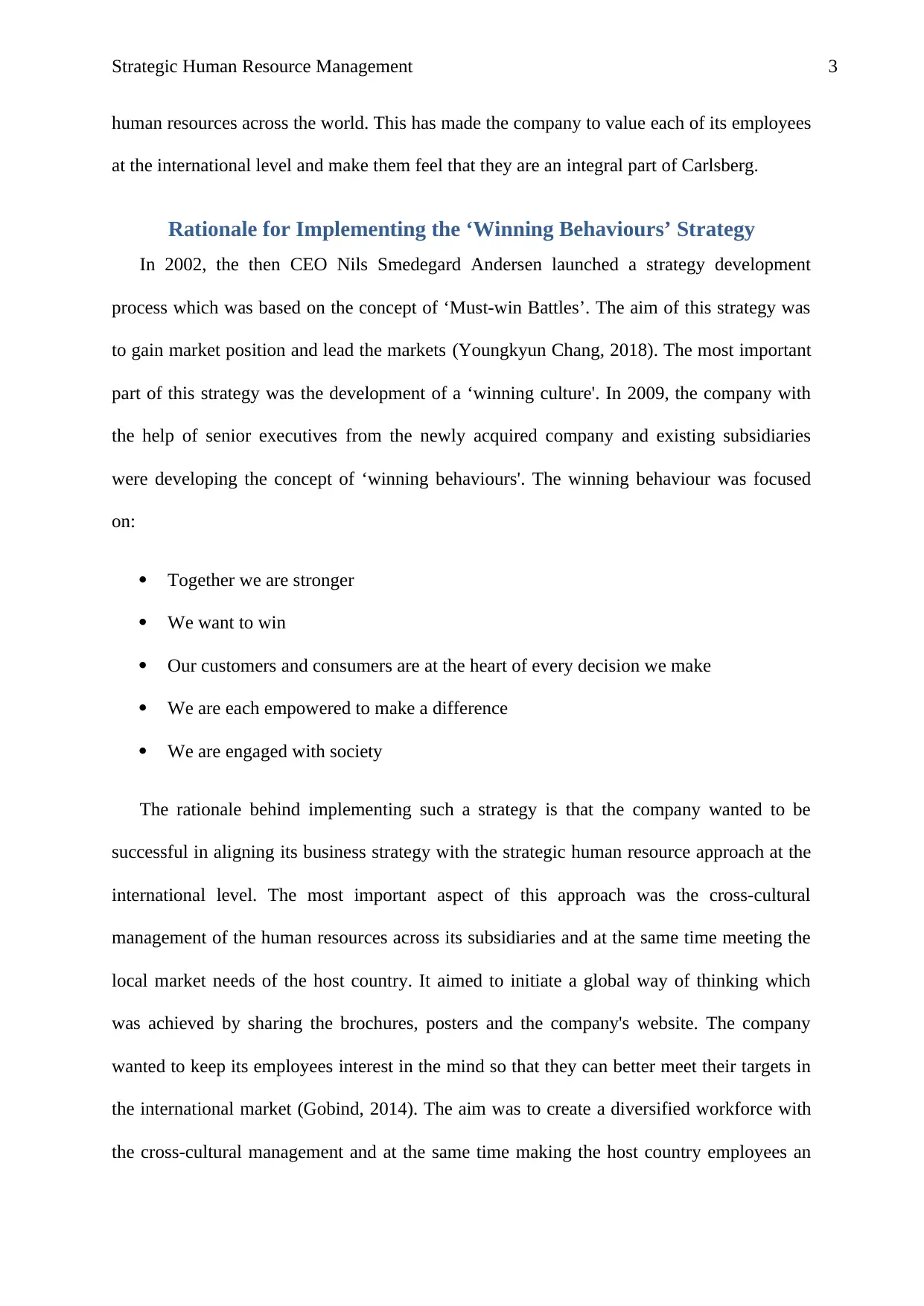
Strategic Human Resource Management 3
human resources across the world. This has made the company to value each of its employees
at the international level and make them feel that they are an integral part of Carlsberg.
Rationale for Implementing the ‘Winning Behaviours’ Strategy
In 2002, the then CEO Nils Smedegard Andersen launched a strategy development
process which was based on the concept of ‘Must-win Battles’. The aim of this strategy was
to gain market position and lead the markets (Youngkyun Chang, 2018). The most important
part of this strategy was the development of a ‘winning culture'. In 2009, the company with
the help of senior executives from the newly acquired company and existing subsidiaries
were developing the concept of ‘winning behaviours'. The winning behaviour was focused
on:
Together we are stronger
We want to win
Our customers and consumers are at the heart of every decision we make
We are each empowered to make a difference
We are engaged with society
The rationale behind implementing such a strategy is that the company wanted to be
successful in aligning its business strategy with the strategic human resource approach at the
international level. The most important aspect of this approach was the cross-cultural
management of the human resources across its subsidiaries and at the same time meeting the
local market needs of the host country. It aimed to initiate a global way of thinking which
was achieved by sharing the brochures, posters and the company's website. The company
wanted to keep its employees interest in the mind so that they can better meet their targets in
the international market (Gobind, 2014). The aim was to create a diversified workforce with
the cross-cultural management and at the same time making the host country employees an
human resources across the world. This has made the company to value each of its employees
at the international level and make them feel that they are an integral part of Carlsberg.
Rationale for Implementing the ‘Winning Behaviours’ Strategy
In 2002, the then CEO Nils Smedegard Andersen launched a strategy development
process which was based on the concept of ‘Must-win Battles’. The aim of this strategy was
to gain market position and lead the markets (Youngkyun Chang, 2018). The most important
part of this strategy was the development of a ‘winning culture'. In 2009, the company with
the help of senior executives from the newly acquired company and existing subsidiaries
were developing the concept of ‘winning behaviours'. The winning behaviour was focused
on:
Together we are stronger
We want to win
Our customers and consumers are at the heart of every decision we make
We are each empowered to make a difference
We are engaged with society
The rationale behind implementing such a strategy is that the company wanted to be
successful in aligning its business strategy with the strategic human resource approach at the
international level. The most important aspect of this approach was the cross-cultural
management of the human resources across its subsidiaries and at the same time meeting the
local market needs of the host country. It aimed to initiate a global way of thinking which
was achieved by sharing the brochures, posters and the company's website. The company
wanted to keep its employees interest in the mind so that they can better meet their targets in
the international market (Gobind, 2014). The aim was to create a diversified workforce with
the cross-cultural management and at the same time making the host country employees an
Paraphrase This Document
Need a fresh take? Get an instant paraphrase of this document with our AI Paraphraser

Strategic Human Resource Management 4
integral part by asking them to frame the human resources policies keeping in mind the local
market needs and what will be the most beneficial strategy in terms of the business process.
The strategy is very effective as it focuses on developing behaviour among the
employees that help the company achieve its objective at the international level. The
motivation that we as a team are stronger helps employees in maintaining their focus in
achieving their goals at the international level and that our aim is to win, we are empowered
to make a difference as employees in the host country are given value while framing human
resources policies at the international level. Therefore the whole objective of Carlsberg
behind the winning behaviours is to inculcate in their employees the behaviour which
matches the global requirement to achieve their global processes (Todd & Binns, 2011).
Alignment of ‘winning behavior’ and HR practices
The ‘winning behaviour' strategy of Carlsberg's human resource practices can be best
explained with the example of the company's Malaysia based subsidiary which has diversity
in its culture and has three different ethnic groups. The series of major changes took place in
the subsidiary relating to leadership, organization, production which focussed on creating a
diversified company culture and workplace. The workforce development was kept in focus
when the training exercise was developed by the subsidiary called FAST (fearless, ambitious,
smart, team) which was aimed to make local employees aware of the culture and work more
efficiently and closely. It is basically adopted to promote local culture at the workplace and
provide a healthy workplace for the employees to respect the diversity and adapt the local
culture in business processes (Bagga & Srivastava, 2014). The employees through the
exercise are motivated to work as a team in unity. This matches the Malaysian culture to
work in a peaceful environment. The training sessions were conducted for performance
measurement of the employees. The rewards were given to the employees who were
successful in adapting the winning behaviour and the awards were designed according to the
integral part by asking them to frame the human resources policies keeping in mind the local
market needs and what will be the most beneficial strategy in terms of the business process.
The strategy is very effective as it focuses on developing behaviour among the
employees that help the company achieve its objective at the international level. The
motivation that we as a team are stronger helps employees in maintaining their focus in
achieving their goals at the international level and that our aim is to win, we are empowered
to make a difference as employees in the host country are given value while framing human
resources policies at the international level. Therefore the whole objective of Carlsberg
behind the winning behaviours is to inculcate in their employees the behaviour which
matches the global requirement to achieve their global processes (Todd & Binns, 2011).
Alignment of ‘winning behavior’ and HR practices
The ‘winning behaviour' strategy of Carlsberg's human resource practices can be best
explained with the example of the company's Malaysia based subsidiary which has diversity
in its culture and has three different ethnic groups. The series of major changes took place in
the subsidiary relating to leadership, organization, production which focussed on creating a
diversified company culture and workplace. The workforce development was kept in focus
when the training exercise was developed by the subsidiary called FAST (fearless, ambitious,
smart, team) which was aimed to make local employees aware of the culture and work more
efficiently and closely. It is basically adopted to promote local culture at the workplace and
provide a healthy workplace for the employees to respect the diversity and adapt the local
culture in business processes (Bagga & Srivastava, 2014). The employees through the
exercise are motivated to work as a team in unity. This matches the Malaysian culture to
work in a peaceful environment. The training sessions were conducted for performance
measurement of the employees. The rewards were given to the employees who were
successful in adapting the winning behaviour and the awards were designed according to the
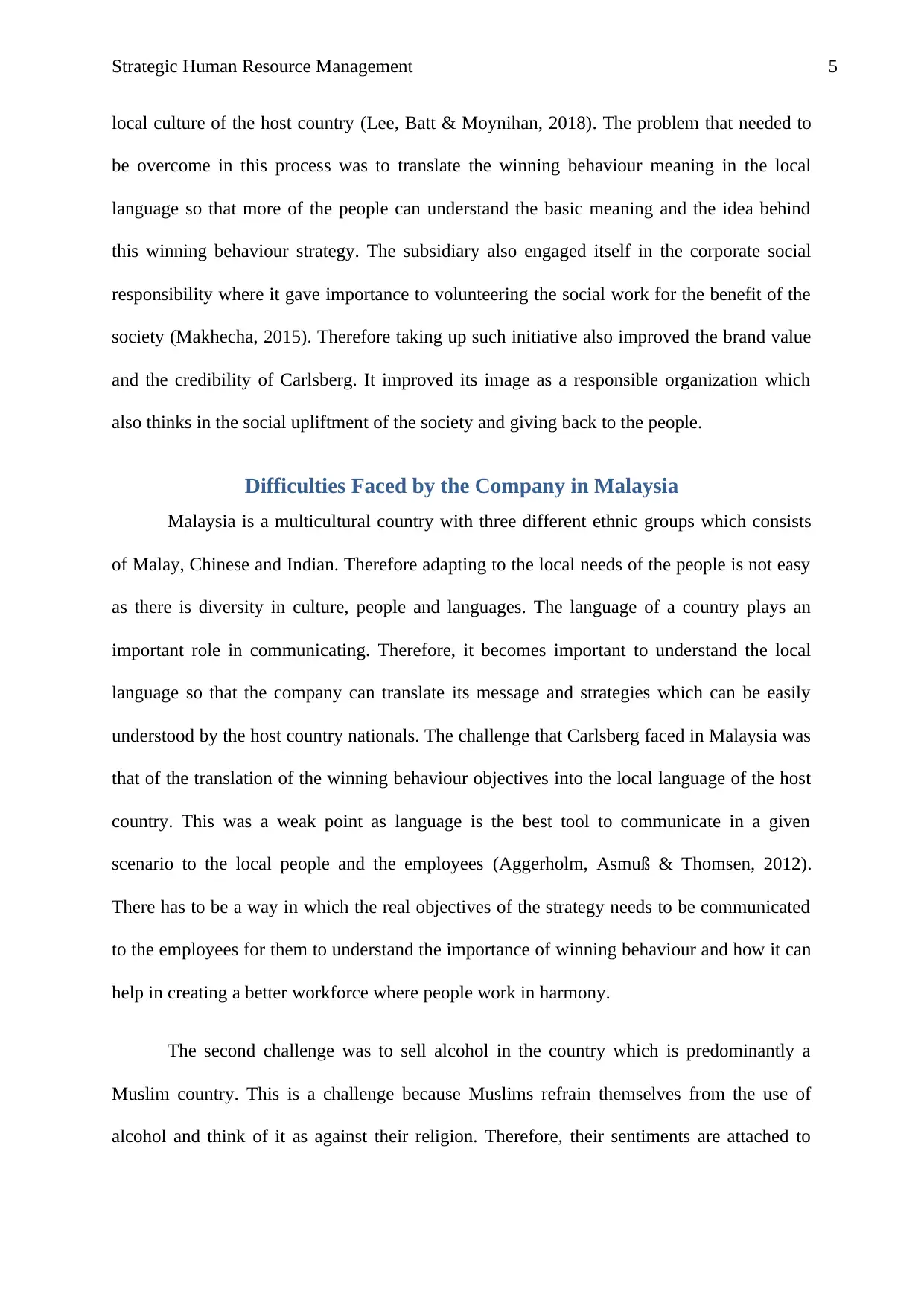
Strategic Human Resource Management 5
local culture of the host country (Lee, Batt & Moynihan, 2018). The problem that needed to
be overcome in this process was to translate the winning behaviour meaning in the local
language so that more of the people can understand the basic meaning and the idea behind
this winning behaviour strategy. The subsidiary also engaged itself in the corporate social
responsibility where it gave importance to volunteering the social work for the benefit of the
society (Makhecha, 2015). Therefore taking up such initiative also improved the brand value
and the credibility of Carlsberg. It improved its image as a responsible organization which
also thinks in the social upliftment of the society and giving back to the people.
Difficulties Faced by the Company in Malaysia
Malaysia is a multicultural country with three different ethnic groups which consists
of Malay, Chinese and Indian. Therefore adapting to the local needs of the people is not easy
as there is diversity in culture, people and languages. The language of a country plays an
important role in communicating. Therefore, it becomes important to understand the local
language so that the company can translate its message and strategies which can be easily
understood by the host country nationals. The challenge that Carlsberg faced in Malaysia was
that of the translation of the winning behaviour objectives into the local language of the host
country. This was a weak point as language is the best tool to communicate in a given
scenario to the local people and the employees (Aggerholm, Asmuß & Thomsen, 2012).
There has to be a way in which the real objectives of the strategy needs to be communicated
to the employees for them to understand the importance of winning behaviour and how it can
help in creating a better workforce where people work in harmony.
The second challenge was to sell alcohol in the country which is predominantly a
Muslim country. This is a challenge because Muslims refrain themselves from the use of
alcohol and think of it as against their religion. Therefore, their sentiments are attached to
local culture of the host country (Lee, Batt & Moynihan, 2018). The problem that needed to
be overcome in this process was to translate the winning behaviour meaning in the local
language so that more of the people can understand the basic meaning and the idea behind
this winning behaviour strategy. The subsidiary also engaged itself in the corporate social
responsibility where it gave importance to volunteering the social work for the benefit of the
society (Makhecha, 2015). Therefore taking up such initiative also improved the brand value
and the credibility of Carlsberg. It improved its image as a responsible organization which
also thinks in the social upliftment of the society and giving back to the people.
Difficulties Faced by the Company in Malaysia
Malaysia is a multicultural country with three different ethnic groups which consists
of Malay, Chinese and Indian. Therefore adapting to the local needs of the people is not easy
as there is diversity in culture, people and languages. The language of a country plays an
important role in communicating. Therefore, it becomes important to understand the local
language so that the company can translate its message and strategies which can be easily
understood by the host country nationals. The challenge that Carlsberg faced in Malaysia was
that of the translation of the winning behaviour objectives into the local language of the host
country. This was a weak point as language is the best tool to communicate in a given
scenario to the local people and the employees (Aggerholm, Asmuß & Thomsen, 2012).
There has to be a way in which the real objectives of the strategy needs to be communicated
to the employees for them to understand the importance of winning behaviour and how it can
help in creating a better workforce where people work in harmony.
The second challenge was to sell alcohol in the country which is predominantly a
Muslim country. This is a challenge because Muslims refrain themselves from the use of
alcohol and think of it as against their religion. Therefore, their sentiments are attached to
⊘ This is a preview!⊘
Do you want full access?
Subscribe today to unlock all pages.

Trusted by 1+ million students worldwide
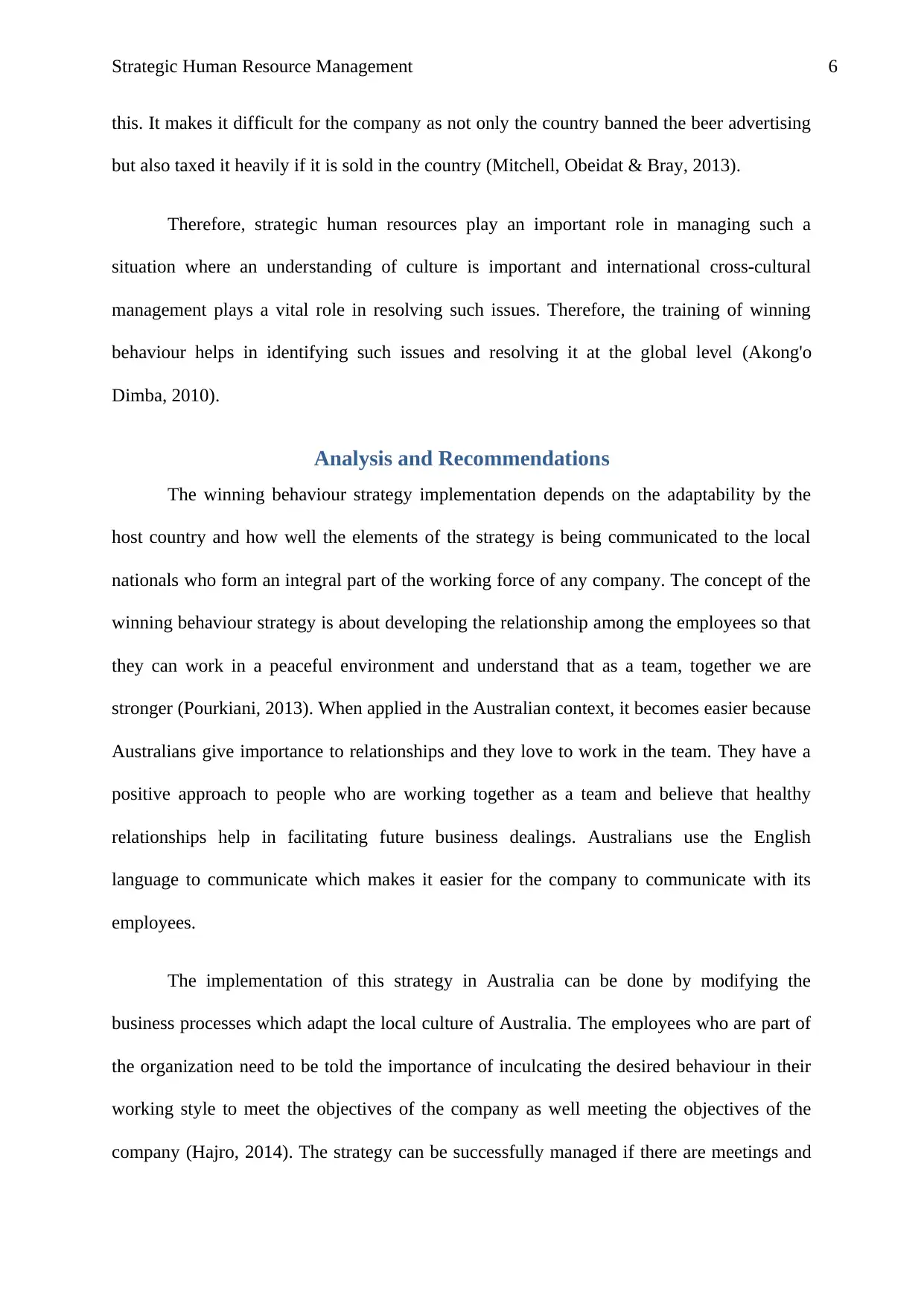
Strategic Human Resource Management 6
this. It makes it difficult for the company as not only the country banned the beer advertising
but also taxed it heavily if it is sold in the country (Mitchell, Obeidat & Bray, 2013).
Therefore, strategic human resources play an important role in managing such a
situation where an understanding of culture is important and international cross-cultural
management plays a vital role in resolving such issues. Therefore, the training of winning
behaviour helps in identifying such issues and resolving it at the global level (Akong'o
Dimba, 2010).
Analysis and Recommendations
The winning behaviour strategy implementation depends on the adaptability by the
host country and how well the elements of the strategy is being communicated to the local
nationals who form an integral part of the working force of any company. The concept of the
winning behaviour strategy is about developing the relationship among the employees so that
they can work in a peaceful environment and understand that as a team, together we are
stronger (Pourkiani, 2013). When applied in the Australian context, it becomes easier because
Australians give importance to relationships and they love to work in the team. They have a
positive approach to people who are working together as a team and believe that healthy
relationships help in facilitating future business dealings. Australians use the English
language to communicate which makes it easier for the company to communicate with its
employees.
The implementation of this strategy in Australia can be done by modifying the
business processes which adapt the local culture of Australia. The employees who are part of
the organization need to be told the importance of inculcating the desired behaviour in their
working style to meet the objectives of the company as well meeting the objectives of the
company (Hajro, 2014). The strategy can be successfully managed if there are meetings and
this. It makes it difficult for the company as not only the country banned the beer advertising
but also taxed it heavily if it is sold in the country (Mitchell, Obeidat & Bray, 2013).
Therefore, strategic human resources play an important role in managing such a
situation where an understanding of culture is important and international cross-cultural
management plays a vital role in resolving such issues. Therefore, the training of winning
behaviour helps in identifying such issues and resolving it at the global level (Akong'o
Dimba, 2010).
Analysis and Recommendations
The winning behaviour strategy implementation depends on the adaptability by the
host country and how well the elements of the strategy is being communicated to the local
nationals who form an integral part of the working force of any company. The concept of the
winning behaviour strategy is about developing the relationship among the employees so that
they can work in a peaceful environment and understand that as a team, together we are
stronger (Pourkiani, 2013). When applied in the Australian context, it becomes easier because
Australians give importance to relationships and they love to work in the team. They have a
positive approach to people who are working together as a team and believe that healthy
relationships help in facilitating future business dealings. Australians use the English
language to communicate which makes it easier for the company to communicate with its
employees.
The implementation of this strategy in Australia can be done by modifying the
business processes which adapt the local culture of Australia. The employees who are part of
the organization need to be told the importance of inculcating the desired behaviour in their
working style to meet the objectives of the company as well meeting the objectives of the
company (Hajro, 2014). The strategy can be successfully managed if there are meetings and
Paraphrase This Document
Need a fresh take? Get an instant paraphrase of this document with our AI Paraphraser
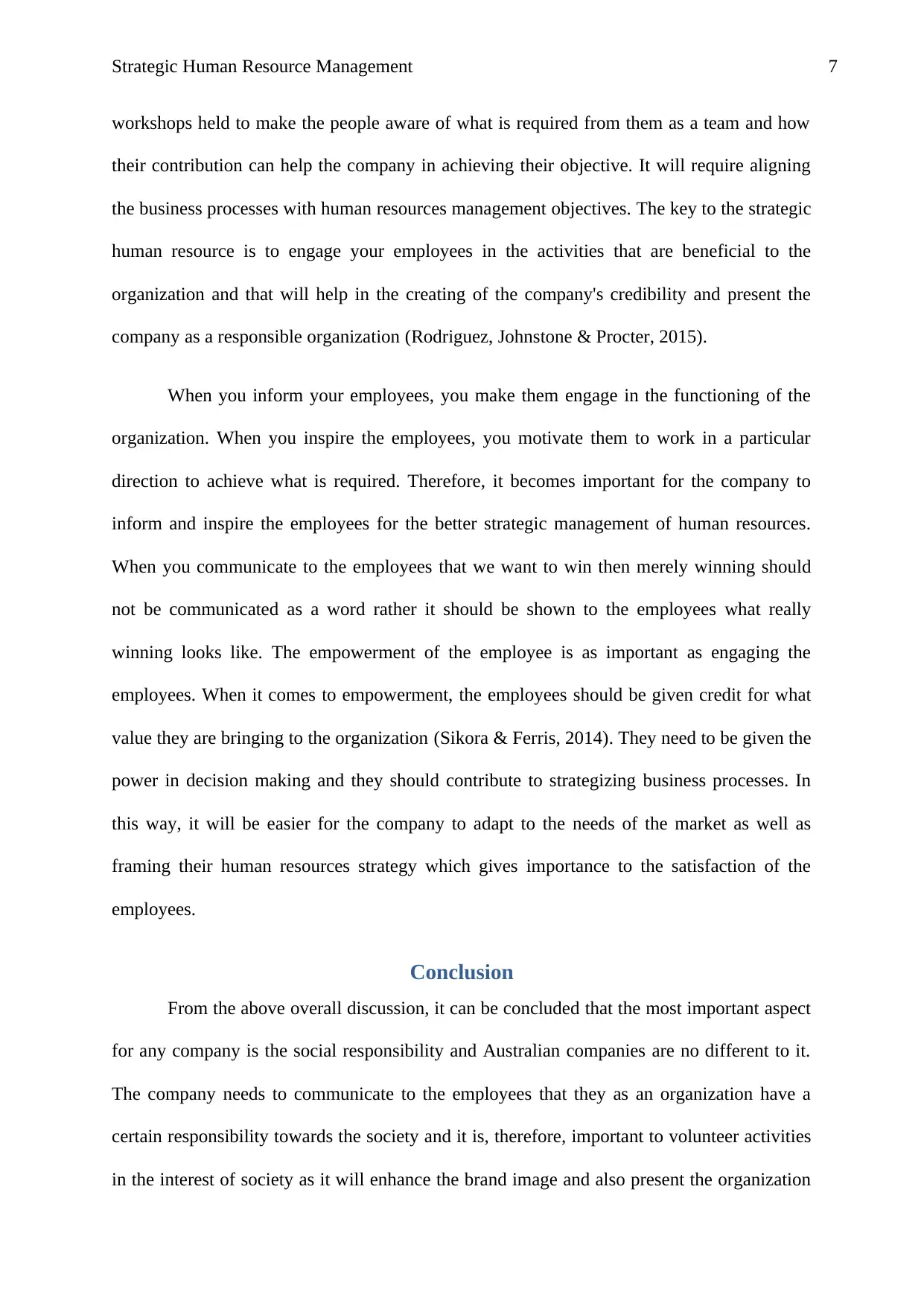
Strategic Human Resource Management 7
workshops held to make the people aware of what is required from them as a team and how
their contribution can help the company in achieving their objective. It will require aligning
the business processes with human resources management objectives. The key to the strategic
human resource is to engage your employees in the activities that are beneficial to the
organization and that will help in the creating of the company's credibility and present the
company as a responsible organization (Rodriguez, Johnstone & Procter, 2015).
When you inform your employees, you make them engage in the functioning of the
organization. When you inspire the employees, you motivate them to work in a particular
direction to achieve what is required. Therefore, it becomes important for the company to
inform and inspire the employees for the better strategic management of human resources.
When you communicate to the employees that we want to win then merely winning should
not be communicated as a word rather it should be shown to the employees what really
winning looks like. The empowerment of the employee is as important as engaging the
employees. When it comes to empowerment, the employees should be given credit for what
value they are bringing to the organization (Sikora & Ferris, 2014). They need to be given the
power in decision making and they should contribute to strategizing business processes. In
this way, it will be easier for the company to adapt to the needs of the market as well as
framing their human resources strategy which gives importance to the satisfaction of the
employees.
Conclusion
From the above overall discussion, it can be concluded that the most important aspect
for any company is the social responsibility and Australian companies are no different to it.
The company needs to communicate to the employees that they as an organization have a
certain responsibility towards the society and it is, therefore, important to volunteer activities
in the interest of society as it will enhance the brand image and also present the organization
workshops held to make the people aware of what is required from them as a team and how
their contribution can help the company in achieving their objective. It will require aligning
the business processes with human resources management objectives. The key to the strategic
human resource is to engage your employees in the activities that are beneficial to the
organization and that will help in the creating of the company's credibility and present the
company as a responsible organization (Rodriguez, Johnstone & Procter, 2015).
When you inform your employees, you make them engage in the functioning of the
organization. When you inspire the employees, you motivate them to work in a particular
direction to achieve what is required. Therefore, it becomes important for the company to
inform and inspire the employees for the better strategic management of human resources.
When you communicate to the employees that we want to win then merely winning should
not be communicated as a word rather it should be shown to the employees what really
winning looks like. The empowerment of the employee is as important as engaging the
employees. When it comes to empowerment, the employees should be given credit for what
value they are bringing to the organization (Sikora & Ferris, 2014). They need to be given the
power in decision making and they should contribute to strategizing business processes. In
this way, it will be easier for the company to adapt to the needs of the market as well as
framing their human resources strategy which gives importance to the satisfaction of the
employees.
Conclusion
From the above overall discussion, it can be concluded that the most important aspect
for any company is the social responsibility and Australian companies are no different to it.
The company needs to communicate to the employees that they as an organization have a
certain responsibility towards the society and it is, therefore, important to volunteer activities
in the interest of society as it will enhance the brand image and also present the organization
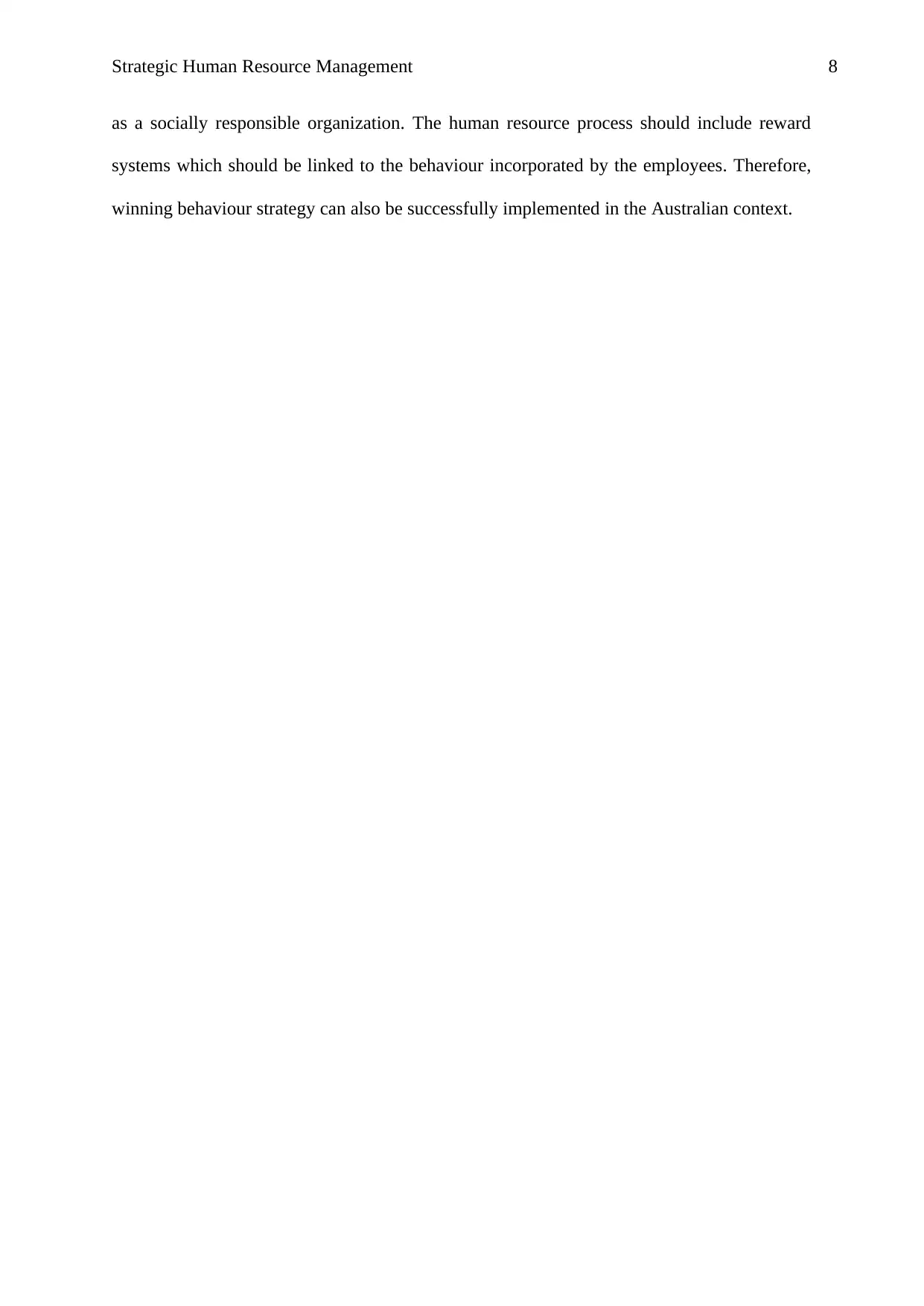
Strategic Human Resource Management 8
as a socially responsible organization. The human resource process should include reward
systems which should be linked to the behaviour incorporated by the employees. Therefore,
winning behaviour strategy can also be successfully implemented in the Australian context.
as a socially responsible organization. The human resource process should include reward
systems which should be linked to the behaviour incorporated by the employees. Therefore,
winning behaviour strategy can also be successfully implemented in the Australian context.
⊘ This is a preview!⊘
Do you want full access?
Subscribe today to unlock all pages.

Trusted by 1+ million students worldwide

Strategic Human Resource Management 9
References
Aggerholm, H., Asmuß, B., & Thomsen, C. (2012). The Role of Recontextualization in the
Multivocal, Ambiguous Process of Strategizing. Journal Of Management Inquiry, 21(4), 413-
428.
Akong'o Dimba, B. (2010). Strategic human resource management practices: effect on
performance. African Journal Of Economic And Management Studies, 1(2), 128-137.
Bagga, T., & Srivastava, S. (2014). SHRM: alignment of HR function with business
strategy. Strategic HR Review, 13(4/5).
Beer, M. (2015). HRM at a Crossroads: Comments on “Evolution of Strategic HRM Through
Two Founding Books: A 30th Anniversary Perspective on Development of the
Field”. Human Resource Management, 54(3), 417-421.
Gertsen, M., Søderberg, A., & Zølner, M. (2012). Global collaboration. Basingstoke: Palgrave
Macmillan.
Gobind, J. (2014). Strategic human resource management: A brief introduction. SA Journal Of
Human Resource Management, 14(1).
Hajro, A. (2014). Cultural influences and the mediating role of socio-cultural integration
processes on the performance of cross-border mergers and acquisitions. The International
Journal Of Human Resource Management, 26(2), 192-215.
Lee, J., Batt, R., & Moynihan, L. (2018). Strategic Dilemmas: How Managers Use HR Practices
to Meet Multiple Goals. British Journal Of Industrial Relations.
Makhecha, U. (2015). Is Strategic HR Alignment Sufficient? - A Study of HR Practices in a Retail
Chain. NHRD Network Journal, 8(2), 93-96.
References
Aggerholm, H., Asmuß, B., & Thomsen, C. (2012). The Role of Recontextualization in the
Multivocal, Ambiguous Process of Strategizing. Journal Of Management Inquiry, 21(4), 413-
428.
Akong'o Dimba, B. (2010). Strategic human resource management practices: effect on
performance. African Journal Of Economic And Management Studies, 1(2), 128-137.
Bagga, T., & Srivastava, S. (2014). SHRM: alignment of HR function with business
strategy. Strategic HR Review, 13(4/5).
Beer, M. (2015). HRM at a Crossroads: Comments on “Evolution of Strategic HRM Through
Two Founding Books: A 30th Anniversary Perspective on Development of the
Field”. Human Resource Management, 54(3), 417-421.
Gertsen, M., Søderberg, A., & Zølner, M. (2012). Global collaboration. Basingstoke: Palgrave
Macmillan.
Gobind, J. (2014). Strategic human resource management: A brief introduction. SA Journal Of
Human Resource Management, 14(1).
Hajro, A. (2014). Cultural influences and the mediating role of socio-cultural integration
processes on the performance of cross-border mergers and acquisitions. The International
Journal Of Human Resource Management, 26(2), 192-215.
Lee, J., Batt, R., & Moynihan, L. (2018). Strategic Dilemmas: How Managers Use HR Practices
to Meet Multiple Goals. British Journal Of Industrial Relations.
Makhecha, U. (2015). Is Strategic HR Alignment Sufficient? - A Study of HR Practices in a Retail
Chain. NHRD Network Journal, 8(2), 93-96.
Paraphrase This Document
Need a fresh take? Get an instant paraphrase of this document with our AI Paraphraser

Strategic Human Resource Management 10
Mitchell, R., Obeidat, S., & Bray, M. (2013). The Effect of Strategic Human Resource
Management on Organizational Performance: The Mediating Role of High-Performance
Human Resource Practices. Human Resource Management, 52(6), 899-921.
Pourkiani, M. (2013). Strategic Human Resource Management and Organizational Knowledge
Creation Capability. International Journal Of E-Education, E-Business, E-Management And
E-Learning.
Rodriguez, J., Johnstone, S., & Procter, S. (2015). Special issue ofInternational Journal of Human
Resource Management: Regulation of work and employment: advancing theory and research
in international and comparative human resource management. The International Journal Of
Human Resource Management, 26(13), 1782-1784.
Sikora, D., & Ferris, G. (2014). Strategic human resource practice implementation: The critical
role of line management. Human Resource Management Review, 24(3), 271-281.
Todd, P., & Binns, J. (2011). Work-life Balance: Is it Now a Problem for Management?. Gender,
Work & Organization, 20(3), 219-231.
Youngkyun Chang. (2018). Do HR Practices Make Social Investment Recoupable? An
Introduction to CSR-Supportive HR Practices. Korean Journal Of Business Ethics, 18(1), 81-
116.
Yuile, C., Chang, A., Gudmundsson, A., & Sawang, S. (2012). The role of life friendly policies on
employees' work-life balance. Journal Of Management & Organization, 18(1), 53-63.
Mitchell, R., Obeidat, S., & Bray, M. (2013). The Effect of Strategic Human Resource
Management on Organizational Performance: The Mediating Role of High-Performance
Human Resource Practices. Human Resource Management, 52(6), 899-921.
Pourkiani, M. (2013). Strategic Human Resource Management and Organizational Knowledge
Creation Capability. International Journal Of E-Education, E-Business, E-Management And
E-Learning.
Rodriguez, J., Johnstone, S., & Procter, S. (2015). Special issue ofInternational Journal of Human
Resource Management: Regulation of work and employment: advancing theory and research
in international and comparative human resource management. The International Journal Of
Human Resource Management, 26(13), 1782-1784.
Sikora, D., & Ferris, G. (2014). Strategic human resource practice implementation: The critical
role of line management. Human Resource Management Review, 24(3), 271-281.
Todd, P., & Binns, J. (2011). Work-life Balance: Is it Now a Problem for Management?. Gender,
Work & Organization, 20(3), 219-231.
Youngkyun Chang. (2018). Do HR Practices Make Social Investment Recoupable? An
Introduction to CSR-Supportive HR Practices. Korean Journal Of Business Ethics, 18(1), 81-
116.
Yuile, C., Chang, A., Gudmundsson, A., & Sawang, S. (2012). The role of life friendly policies on
employees' work-life balance. Journal Of Management & Organization, 18(1), 53-63.
1 out of 11
Related Documents
Your All-in-One AI-Powered Toolkit for Academic Success.
+13062052269
info@desklib.com
Available 24*7 on WhatsApp / Email
![[object Object]](/_next/static/media/star-bottom.7253800d.svg)
Unlock your academic potential
Copyright © 2020–2025 A2Z Services. All Rights Reserved. Developed and managed by ZUCOL.



